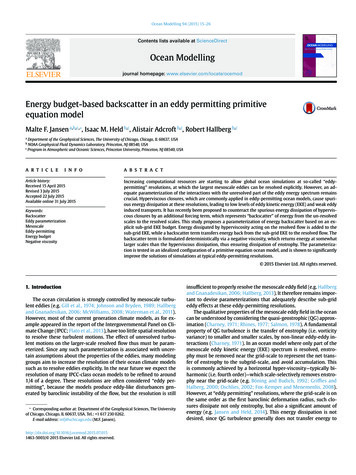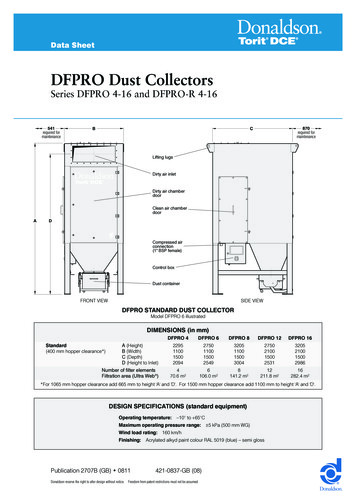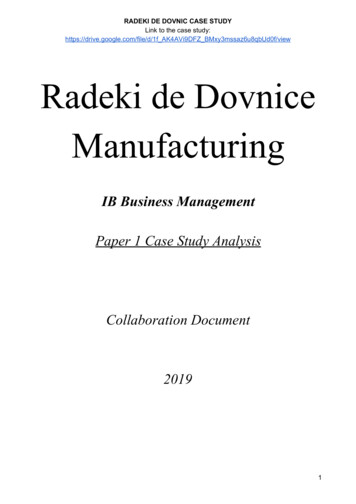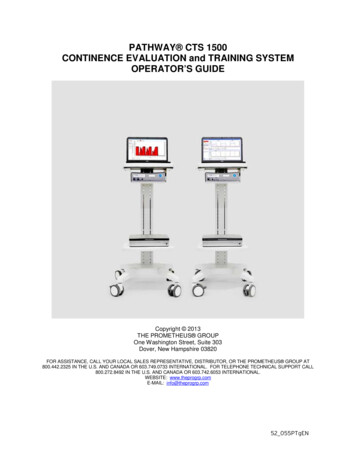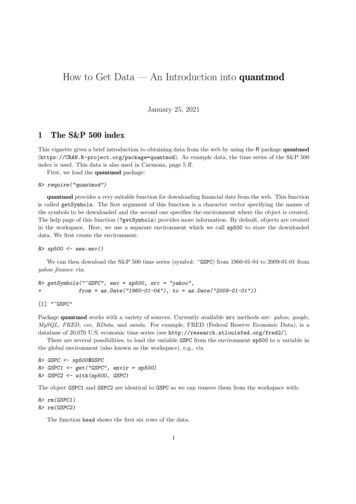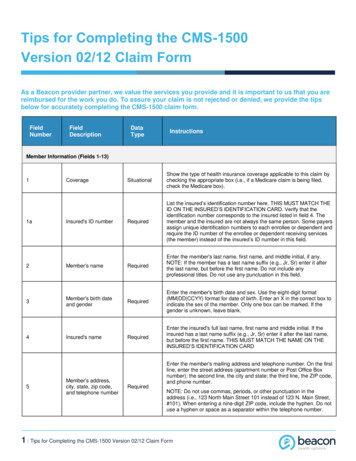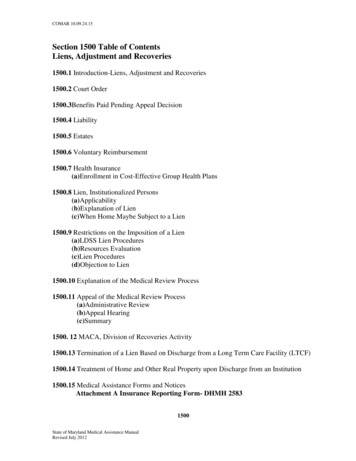
Transcription
COMAR 10.09.24.15Section 1500 Table of ContentsLiens, Adjustment and Recoveries1500.1 Introduction-Liens, Adjustment and Recoveries1500.2 Court Order1500.3Benefits Paid Pending Appeal Decision1500.4 Liability1500.5 Estates1500.6 Voluntary Reimbursement1500.7 Health Insurance(a)Enrollment in Cost-Effective Group Health Plans1500.8 Lien, Institutionalized Persons(a)Applicability(b)Explanation of Lien(c)When Home Maybe Subject to a Lien1500.9 Restrictions on the Imposition of a Lien(a)LDSS Lien Procedures(b)Resources Evaluation(c)Lien Procedures(d)Objection to Lien1500.10 Explanation of the Medical Review Process1500.11 Appeal of the Medical Review Process(a)Administrative Review(b)Appeal Hearing(c)Summary1500. 12 MACA, Division of Recoveries Activity1500.13 Termination of a Lien Based on Discharge from a Long Term Care Facility (LTCF)1500.14 Treatment of Home and Other Real Property upon Discharge from an Institution1500.15 Medical Assistance Forms and NoticesAttachment A Insurance Reporting Form- DHMH 25831500State of Maryland Medical Assistance ManualRevised July 2012
COMAR 10.09.24.15Attachment B Note of Potential MA Payment Recovery-DHMH 1169Attachment C Referral for Investigation-DHMH 4243Attachment D Explanation of Lien-DHMH 4244Attachment E Physician Report-DHMH 4245 (LTC)Attachment F Lien Worksheet-DHMH 1159C (LTC)Attachment G Lien Memorandum- DHMH 4242 (LTC)Attachment H Home Exclusion-Statement of Intent DHMH 4255 (LTC)Attachment I Notice of Medical Review Decision-Home Property-DHMH 42551500.16 Lien Process Flow Chart for Institutionalized PersonsFrequently Asked Questions (FAQs) and AnswersObjectives for Section 15001. Define Liens, Adjustments and Recoveries;2. Provide in detail Restrictions on the Imposition of a Lien;3. Explain the Medical Review Process.1501State of Maryland Medical Assistance ManualRevised July 2012
COMAR 10.09.24.151500.1 Introduction- Liens, Adjustment and RecoveriesThe Department has the right to make a claim against a recipient‟s income and/or resourcesunder several circumstances. These circumstances are:A court order exists which permits the Department to take such action.MA benefits have been paid pending an appeal hearing.A third party may be responsible for medical expenses as a result of a lawsuit or otherlegal action.The recipient is deceased and received MA benefits at 55 or over.A recipient voluntarily reimburses the Program for expenditures.Health insurance coverage is available to cover expenses paid by the Department.An institutionalized person owns real property against which a lien may be placed.The Department may not seek recovery from the estate of the deceased individual forMedical Assistance payments of Medicare premiums, co-payments, or deductibles as aQualified Medicare Beneficiary (QMB) or Specified Low Income Medicare Beneficiary(SLMB).Claims against a recipient‟s income and/or resources are made by the Division of Recoveriesand Financial Services (Recoveries). This unit is responsible for carrying out all activities tomake claims and recoveries on behalf of the Department; however, the activities ofRecoveries must be coordinated with those of the LDSS. The LDSS is responsible forreporting complete information to Recoveries to enable that unit to pursue claims andrecoveries. The extent to which claims and recoveries are made and the appropriateness ofcertain legal actions are the responsibility of Recoveries.Address:Medical Care Compliance Administration, Division of Medical Assistance Recoveries,201 West Preston StreetRm 204Baltimore, MD 21201Phone number: 410-767-66141500.2 Court Order1502State of Maryland Medical Assistance ManualRevised July 2012
COMAR 10.09.24.15A court order permitting recovery may exist because of a determination that the Program haspaid benefits on behalf of a person that should not have been paid or would have been paid ina lesser amount had the A/R or representative accurately provided required information andreported changes in a timely manner.It is the responsibility of the LDSS to report any incident in which income, resources or otherfactors that could affect eligibility have been:unreported,reported in an untimely manner, orErroneously reported.The LDSS must report such incidents on the DHMH 4243, Referral for Investigation. TheDHMH Office of the Inspector General (OIG) will decide what action is appropriate basedon its findings. Criminal or Civil action may be indicated, or an agreement may be reachedbetween the Department and the recipient for reimbursement of incorrectly paid funds. TheOIG may also decide that no action is warranted. However, prompt reporting on the DHMH4243, and clear, accurate, complete case records are essential for the effectiveness ofrecoveries by the OIG.The LDSS should also report any suspected provider fraud or abuse, or recipient abuse of thecard to OIG for appropriate action. These may be reported by telephone call or memo to theOIG.1500.3 Benefits Paid Pending Appeal DecisionRegulations require that each case of a person receiving extended benefits pending a hearingdecision be referred to the MACA Division of Recoveries via form DHMH 1169 if thehearing officer upholds the decision of the LDSS.The Division of Recoveries will initiate steps to recover the cost of expenditures made onbehalf of the recipient during the appeal process. Exempt from this provision is a personwho requests a hearing with a bona fide belief that the LDSS‟ action to cancel MedicalAssistance benefits was incorrectly based; for example, on the misapplication of policy, anerror in the amount of income and/or resources considered incorrect application of disregardsor exclusions, or an otherwise incorrect calculation. The basis for the appeal should beindicated on the DHMH form letter or other written notice requesting appeal.The Division of Recoveries will decide, on the basis of the stated factors, if the exemption isapplicable.1500.4 LiabilityThe MA Program will obtain reimbursement in any case in which a MA recipient has acause of action against another party if the Program has paid out benefits for medical care1503State of Maryland Medical Assistance ManualRevised July 2012
COMAR 10.09.24.15for which the other party was responsible. In any case where a third party may be liable formedical expenses, complete an 1169 reporting such a situation to the Division of Recoveries.Liability cases may involve personal injuries resulting from automobile accidents,malpractice suits, lead paint poisonings, or accidental injuries sustained on the premises ofanother individual. The Legal Liabilities Section will contact the recipient, his attorney, andthe insurance company to request reimbursement from any settlement funds. The amount ofreimbursement requested will not exceed the amount of the accident related services paid bythe MA Program.Workmen‟s Compensation cases are a specialized type of Liability case in which an injuryhas occurred as a result of the person‟s job or at his place of employment. If the MAProgram has paid for the cost of treatment for any work related injuries, the Legal LiabilitiesSection will seek to recover the pertinent costs from the Workmen‟s Compensation insurancecarrier or the self- insured employer.If a recipient has been criminally assaulted by another person, the Legal Liabilities Sectionwill attempt to recover for the Program the cost of all assault related treatment from theinvolved third party, i.e., the defendant.The LDSS must report any cases involving legal liability, lawsuits, paternity, support orders,Workmen‟s Compensation, assault or accidental injuries to the Division of Recoveries viathe DHMH 1169. It is essential to supply complete and accurate information on the 1169,and it is the responsibility of the A/R to provide this information to the LDSS. The casesinvolving lawsuits and potential settlements must be flagged for review as appropriate, andthe results of the review reported to the Division of Recoveries.1500.5 EstatesThe Division of Recoveries will pursue recovery from the estates of decreased recipientswhen legally possible. Recovery is usually pursued by filing a claim against the open estateof the decreased. For MA recipients, the Division of Recoveries will seek to recover allpayments made on behalf of the recipient after the recipient became age 65, unless therecipient is survived by:A spouse (even if separated);A unmarried child under 21; orA blind or disabled child of any age.The Division may waive its right to recover in “hardship” cases.If there are recoverable resources, the LDSS must refer the case to the Division of Recoveriesvia Form 1169. Recoverable resources include the 2,500 resources limit or any portion,thereof for an individual‟s if left in an estate and not used for other purposes. If is not1504State of Maryland Medical Assistance ManualRevised July 2012
COMAR 10.09.24.15necessary for the LDSS to complete a Form 1169 for the sole purpose of reporting a death.This information is now provided to the Division of Recoveries by means of a monthlycomputer list from the Division of Vital Statistics.Note: No recovery for recipients of QMB, SLMB only effective 03/03.1500.6 Voluntary ReimbursementThe Program will accept any reimbursement when voluntarily offered by a current or formerrecipient or someone acting on the recipient‟s behalf for correct and incorrect payments madeon a person‟s behalf.Voluntary reimbursements are often made in order to properly reduce excess resources. If arecipient is found to have excess resources, timely notice of the case closing must be given.During the timely notice period, the person may reduce resources by voluntarily reimbursingthe program and eligibility may continue uninterrupted. Case closing may not be delayedbeyond the timely notice period to allow for reimbursement.In addition to excess resource situations, voluntary reimbursement may be made to theProgram for services covered during a period of ineligibility. This situation may occur as aresult of either client or agency error.Voluntary reimbursements may not be regarded as an eligibility requirement. A recipient‟sintent to make voluntary reimbursement does not change the requirement that the LDSS takeappropriate action, e.g. closing, notification of ineligibility, referral to OIG, or Division ofRecoveries, etc. In the case of excess resources, verification that the reimbursement has beenmade must be received in order to prevent the case closing or to reopen the case atreapplication.1500.7 Health Insurance(CM) need to aware of the possibility of health insurance through a place of employment, aunion or trade association, a separated spouse or an absent parent. The coverage may becarried by a non-assistance unit member.Health insurance information is collected by the LDSS and reported on CARES. Bysignature on the application, an applicant agrees to assign to the Program all health insuranceor other third party payments to the extent that the Program will pay for his/her medicalservices. Eligibility may not be denied to an eligible person who cannot legally assign hisown rights when the person who can legally assign his rights refuses to make any assignmentof benefits to the Program. The Insurance Recovery section of MACA is responsible formaintaining health insurance coverage information on MA recipients and assuring paymentsby insurance before program payments are made.1505State of Maryland Medical Assistance ManualRevised July 2012
COMAR 10.09.24.15When an applicant applies for Medical Assistance, the CM must ascertain whether there isany insurance which may be used to cover any medical services. (This includes any potentialinsurance from a former employer within the last 2 months prior to the month of application.)Information on insurance should be ascertained and referred to the Division of MedicalAssistance Recoveries via the Form 2583.1500.8 Lien, Institutionalized Persons(a) ApplicabilityThis section and the following sections apply to:1. An institutionalized person who owns excluded home property and has met all otherfactors of eligibility, including resource eligibility, but who has not been certified;and2. A current institutionalized recipient (including and SSI recipient) who owns excludedhome property which has not been evaluated base on the revised definition of “home”and the home exclusion provision, (Regulation.08 B, G, H, and H-1), or in terms ofthe lien provision, Regulation 15.This section and the sections which follow do not apply to a person who is not eligiblefor MA, including one who has excess resources.(b) Explanation of LienUnder certain circumstances, the Department may impose a lien on the excluded home andother real property of an institutionalized person including that which is located out of State.(Refer to Chapter 8, Policy Alert, and Evaluation of the Home Property of theInstitutionalized Person). A lien is a claim on the property of a person as security for thepayment of a debt. The lien enables the Program to recover Program expenditures formedical expenses paid on behalf of the person when property is sold.The lien provision applies to excluded home property of an eligible institutionalized person.If a lien applies to the home property, it also applies to the following other real properties:1. Other real property which meets the 6,000/6% equity value exclusion;2. Non-excluded real property the value of which, together with other countableresources, is within the applicable resources standard; and3. Real property which is deeded as Tenancy by the Entireties. Tenancy by the Entiretiesmeans:o Each owner has an undivided, one- half share of the property;o Only the entire interest may be transferred to a third party;1506State of Maryland Medical Assistance ManualRevised July 2012
COMAR 10.09.24.15o The co-owners are husband and wife (Tenancy by the Entireties lasts only solong as the co owners are married); ando When one co-owner dies, the co owner‟s interest passes automatically to hisor her spouse.If the resource evaluation, based on Regulation .08, revealed that the institutionalized personowns no home property, the lien provision does not apply and no further action is requiredunder this section. Neither does the lien provision apply to home property which is notexcluded.(c)When Home Property May be Subject to a LienThe circumstances under which a lien may be imposed on the home property of aninstitutionalized person are as follows:1. The person is a patient in an Long Term Care Facility( LTCF);2. The person owns excluded home property;3. The person has been determined eligible for Medical Assistance, including resourceseligibility, with countable and excluded real property within the specified limits; and4. The Department has determined, after notice and opportunity for a hearing, that thereis no reasonable expectation that the person can be discharged from the LTCF andreturn to live in his home property. (The fact that the person‟s home property hasbeen excluded for eligibility purposes based on his/her expressed intent to return to itdoes not preclude the imposition of a lien if the requirements of the lien provision aremet.)The LDSS must refer to MACA via DHMH Form 1159C, Lien Worksheet, all cases ofpersons meeting all of the conditions indicated above. Complete LDSS referral proceduresare included in this chapter.1500.9 Restrictions on the Imposition of a LienThere are some restrictions on imposing a lien on the excluded home of an institutionalizedperson. The Department may not impose a lien on the home of an institutionalized person ifany of the following relatives reside in the home with the permission of the owner (or, ifunder guardianship, the permission of the owner‟s legal guardian). For purposes of the lienprocedures, these relatives are referred to as “specified relatives”:The person‟s spouse;The person‟s unmarried child younger than 21 years old;The person‟s son or daughter who is blind or disabled (as determined by the SocialSecurity Administration (SSA), or State Review Team(SRT) as a part of an MAeligibility determination process); or1507State of Maryland Medical Assistance ManualRevised July 2012
COMAR 10.09.24.15The person‟s sibling (full, half, step, or adoptive), who has an equity interest in thehome and who was residing in the home for a period of at least one year immediatelybefore the date of the institutionalized person‟s admission to a LTCF. (Equity interestin the home means co-ownership of the home which is not the result of a transfer ofthe property for less than the fair market value within two years prior to the person‟sinstitutionalization).(a) LDSS Lien ProceduresThis section describes the procedures for determining if the Program may impose a lienon a person‟s home property and/or other real property. The procedures apply to alleligible persons residing in a LTCF who own an excluded home. The lienimplementation process (if applicable) takes place after the eligibility determinationprocess has been completed. The person must have been determined eligible for MA andown excluded home property in order for the CM to apply the lien procedures.Certification of the eligible person is discussed in STEP 6 of this section.(b) Resource EvaluationProperty which meets the definition of “home” must be identified to determine if the lienprovision applies. Others residing in the person‟s home property must be identified todetermine if the Program is restricted from imposing a lien on the home property becauseof its occupancy by a “specified relative.” If the institutionalized person‟s home propertyis subject to a lien, then the person‟s other real property is also subject to a lien. If thehome property is not subject to a lien, then the person‟s other real property is not subjectto a lien either.The LDSS must refer all lien cases including those with out-of-State property to MACA.(c) Lien ProceduresWhen the resource evaluation revealed that the eligible institutionalized person ownsexcluded home property, follow the procedures detailed below:STEP 1Complete Part 1 of DHMH Form 1159C, Lien Worksheet. On the worksheet, classify allreal property that the person owns as either “home property” or “other real property”.STEP 2Complete DHMH Form 4244 (LTC), Explanation of Lien. Give the original copy of theform to the person or the person‟s representative. An additional copy is provided asneeded. Explain the following points:1508State of Maryland Medical Assistance ManualRevised July 2012
COMAR 10.09.24.15That a lien is a claim against a person‟s property as security for payment of adebt. For MA recipients, this means, when the property is sold, the Program willbe entitled to an amount up to that which has been expended on recipient‟s behalf.That a lien does not affect ownership interest in a property until it is sold, atwhich time the Program will be entitled to reimbursement for expenditures paidon behalf of the recipient.That if the home is occupied by a “specified relative”, the lien will not beimposed. (Refer to Restriction on the Imposition of a Lien).NOTE: The fact that a “dependent relative” lives in the home which may result inthe exclusion of the home as a resource, does not preclude imposition of a lien.(Refer to Chapter 8, Evaluation of the Home Property of an InstitutionalizedPerson for a listing of “dependent relatives).That a medical review will be conducted to determine if there is a reasonableexpectation that the person will be able to return to live in his/her home property.If the person is expected to return, the lien will not be imposed. If the person isnot expected to return, the lien will be imposed.That if a lien is imposed and the person is discharged from the LTCF and resumesliving in his/her home property, the lien will be lifted. If the person is dischargedbut does not resume living in the home property, the lien may not be lifted.That disposal of the home property for less than fair market value within 60months prior to or subsequent to the month of application may result inineligibility. This applies even if the institutionalized person was living in thehome at the time of disposal. Transfer of the home to the spouse, unmarried childunder 21, or a blind or disabled son or daughter of any age will not affecteligibility. (Refer to Chapter 8, Disposal of Resources).STEP 3Determine if the home property is occupied by the person‟s spouse, unmarried childunder 21, blind or disabled son or daughter of any age, or brother or sister, who satisfythe conditions specified under the section Restrictions on the Imposition of a Lien.a. If the home is occupied by anyone of these “specified relatives listed above,the lien will not be imposed. Inform the representative that any change inoccupancy must be reported. GO TO STEP 4ab. If the home is not occupied by anyone of these “specified relatives”, the homeand other real property may be subject to a lien. GO TO STEP 4bSTEP 4Is the Physician Report (DHMH Form 4245 LTC) required?a. The Physician Report is not required when the home is occupied by “specifiedrelatives”, (Step 3 a). File the Explanation of Lien and Lien Worksheet in the case1509State of Maryland Medical Assistance ManualRevised July 2012
COMAR 10.09.24.15record and complete the case. Certify the eligible person. COMPLETE OTHERCASE ACTIVITY.b. The Physician Report is required when there are no restrictions on the imposition of alien on the home property (Step 3 b). Compete Part I of the Physician Report andgive the Report to the representative to have the person„s attending physiciancomplete Part II. Require return of the completed Physician Report within anadequate period of time to allow for timely Medical Review. GO TO STEP 5STEP 5Upon receipt of the completed Physician Report, forward the original of the report to UCA.a. If there is no objection to the imposition of the lien, complete the case. Certify theeligible person. Once MA has been accepted, the person no longer has the option ofobjecting to the imposition of the lien, GO TO STEP 6b. If there is objection to the imposition of the lien, delay certification until the MedicalReview decision has been received. GO TO STEP 6STEP 6Upon receipt of the Medical Review decision (DHMH Form 4246 (LTC) - Notice of MedicalReview Decision Home Property) from UCA, take the appropriate actions:a. If, based on the Medical Review decision, discharge from the institution and returningto live in the home property can be reasonably expected, no lien will be imposed.Complete the following activities:Complete and file the Lien Worksheet and the Notice of Medical ReviewDecision- Home Property in the case record.If certification was delayed under step 5b, complete the case.Certify the eligible person.If the person has already been certified under step 5b, complete the case.COMPLETE OTHER CASE ACTIVITY.b. If, based on the medical review decision, discharge from the institution and returningto live in the home property cannot be reasonably expected, the Program will imposea lien on the home property and other real property. Complete the followingactivities:No Objection to LienFor the person who does not object to the imposition of a lien:1510State of Maryland Medical Assistance ManualRevised July 2012
COMAR 10.09.24.15 Complete the Lien Worksheet and forward the original and copies of thedeed(s) and tax assessment(s) for the home property to MACA, Division ofRecoveries. File copy of the Lien Worksheet and the Notice of Medical ReviewDecision-Home Property in the case record. Certify the eligible applicant or continue certification for the eligible recipient.COMPLETE OTHER CASE ACTIVITY.Objection to LienA person who objects to the imposition of a lien is ineligible for MA. Ineligibility is basedon the person‟s objection to the imposition of the lien, which impedes the Program‟s abilityto implement its lien requirements. The basis for this action is COMAR 10.09.24.15A-3(l).The specific reason to be stated on the ineligibility or termination notice is: “You did notwish to subject your home property to the lien requirements of the Program.”Deny eligibility to an applicant.In the case of a recipient, immediate action (termination) in accordance with timelyand adequate notice requirements, Regulation .13, is required to avoid erroneouspaymentsComplete the Lien Worksheet and file it and the Notice Medical Review Decision HomeProperty in the case record.COMPLETE OTHER CASE ACTIVITY.1500.10 Explanation of the Medical Review ProcessTo determine if the program will impose a lien on home property, a Medical Review isrequired. This process is called the “Medical Review” and is conducted for the Program bythe Utilization Control Agent (UCA). Through this process, UCA determines if there is areasonable expectation that the person can be discharged from the institution and resumeliving in his/her home property. If reasonable expectation is not determined to exist, a lienwill be imposed on the home property irrespective of the person‟s expressed intent to return.The LDSS completes Part I of the Physician Report and gives it to the representative to havethe attending physician complete Part II. The physician will return the report to therepresentative, who in turn will forward it to the LDSS.The LDSS will forward the Physician Report to UCA. UCA, using the medical informationprovided on the Level of Care Determination (on file with UCA) and the Physician Report,will complete a Medical Review to determine if there is any reasonable expectation that theperson will be discharged from the LTCF and resume living in the home property. UCA willnotify the person of the decision and his/her right to an appeal hearing via DHMH Form 4246(LTC), Notice of Medical Review Decision- Home Property. The LDSS will receive a copyof this notice.1500.11 Appeal of the Medical Review Decision1511State of Maryland Medical Assistance ManualRevised July 2012
COMAR 10.09.24.15A person has a right to appeal the Medical Review decision made by a UCA within 90 daysof the date of the notice of the decision.(a)Administrative ReviewIf an appeal is filed, the first step of the appeal process involves an administrative reviewof UCA‟s decision by MACA, Division of Long Term Care. MACA may affirm orreverse UCA‟s decision. MACA will notify the person, the person‟s representative, UCA,the Office of Hearings, the LDSS, and the Division of Recoveries of the result of theadministrative review.If the Administrative Review affirms UCA‟s decision, MACA will forward the case to theOffice of Hearings for an appeal hearing. If the Administrative Review reverses UCA‟sdecision, that there is a reasonable expectation the person can resume living in his/herhome, the lien, if already imposed, will be lifted. If not yet imposed, it will not beimposed.(b)Appeal HearingIf the case is forwarded to the Office of Hearings by MACA, an appeal hearing will beheld and a decision rendered concerning the Medical Review decision made by UCA andMACA. When the appeal decision is rendered, the Office of Hearings will notify theperson, the person‟s representative, the LDSS, the Division of Recoveries, and UCA of thedecision.If the Hearing Officer reverses the Medical Review decision made by UCA and MACA,that there is a reasonable expectation that the person can resume living in his home, thelien, if already imposed, will be lifted. If not yet imposed, it will not be imposed.(c) SummaryAlthough the administrative review or appeal hearing decision does not affect MAeligibility, they do affect applicability of the lien provision.If the administrative review or the appeal hearing determined that a lien will not beimposed on the institutionalized person‟s home property and a lien was imposed, theLDSS must notify MACA, Division of Recoveries, via the DHMH Form 4242, LienMemorandum, to lift the lien. The memorandum must include the date of hearing oradministrative review.1500.12 MACA, Division of Recoveries Activity1512State of Maryland Medical Assistance ManualRevised July 2012
COMAR 10.09.24.15The Division of Recoveries will take the appropriate action to impose a lien on homeproperty, including out of State property, and notify the person (or representative) and theLDSS using DHMH Form 4249 (LTC), Notice of Lien Imposition, of the action.In addition, via DHMH Form 4242, Lien Memorandum, the Division of Recoveries willnotify the LDSS of the details of the sale of a property on which a lien has been imposed,including the amount recovered, and the amount remaining, if any, so that the LDSS canmake a determination of continued eligibility.1500.13 Termination of a Lien Based on Discharge from a Long Term Care Facility(LTCF)Any lien imposed against a person‟s property must lift if the person is discharged from aLTCF and returns to his/her home property. The LDSS must determine that the person has infact returned to his/her home property. This applies only to a person who has beendischarged from an LTCF and who returns to his/her property for permanent residence.The LDSS must notify MACA, Division of Recoveries, via the DHMH Form 4242, LienMemorandum, when an institutionalized person has been discharged from a LTCF andresumes permanent residence in his/her home property. The memorandum must include theperson‟s date of discharge, the home address and telephone number and the name, address,and telephone number of a contact person. The Division of Recoveries will processtermination of the lien. If the person is discharged to a residence other than his/her homeproperty, the lien will not be lifted.1500.14 Treatment of Home and Other Real Property upon Discharge from anInstitutionWhen a person is permanently discharged from an LTCF, a redetermination of eligibility isrequired. As part of that redetermination, the LDSS must reevaluate the home property inrelation to the person‟s non-institutional status, (Regulation .08) and make a
1500.8 Lien, Institutionalized Persons (a)Applicability (b)Explanation of Lien (c)When Home Maybe Subject to a Lien 1500.9 Restrictions on the Imposition of a Lien (a)LDSS Lien Procedures (b)Resources Evaluation (c)Lien Procedures (d)Objection to Lien 1500.10 Explanation of the Medical Review Process 1500.11 Appeal of the Medical Review Process

